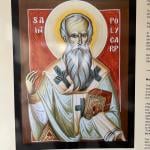In her Baptismal Imagery in Early Christianity: Ritual, Visual, and Theological Dimensions (pp. 190-191), Robin M. Jenson notes that in some early Christian iconography, Peter was substituted for Moses in the scene of the striking of the rock: “In the fourth century . . . the composition of the scene was radically transformed; rather than Moses, it showed the apostle Peter as the rock-striking, staff-wielding wonder-worker. Viewers may easily identify Peter from his unique portrait type (a low forehead, square jaw, short beard, and bushy hair) and from the common juxtaposition of scenes of his denial (designated by a rooter) and arrest.”
Why? Jenson suggests two reasons: “it may reflect an anti-Jewish polemic . . . . Moses represents the ‘Old Law’ that has passed away, and Peter the ‘New Law’ that has replaced it . . . . Since Peter’s name literally means ‘rock’ . . . . he is the obvious one to be charged to strike the rock that is Christ . . . and he is also charged to bring ‘living water’ to the people.” She also points to an account in the Acts of Peter that describes Peter “baptizing his Roman guards, Proclus and Martinus, while he was in jail awaiting execution.”
Perhaps. But the fact that the rooster is present suggests something else: Peter denied Jesus, thus striking the “Rock” that was Christ. He was among the disciples that abandoned Jesus. Yet it was through this abandonment that Jesus becomes the source of living water. The cowardice and betrayal of Peter and the other apostles becomes life for the world.











